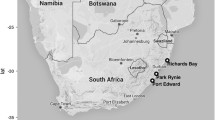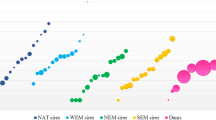Abstract
Long-term changes in the sex ratio have been studied in pink salmon (Oncorhynchus gorbuscha and chum salmon (O. keta) populations of Kamchatka and Sakhalin. It has been demonstrated that these changes are an adaptation to population dynamics: an increase in the population size is accompanied by a shift towards a higher proportion of males; a decrease in population size, by a shift towards a higher proportion of females. The correspondence between morphological and molecular characters in populations of the two species has been analyzed in order to determine the mechanism of sex ratio control. In some pink salmon and chum salmon populations, there is a discrepancy between sex identifications based on morphological characters and molecular markers. This discrepancy is assumed to be accounted for by sex inversion mechanisms, which may be population-or region-specific. In two cases, it has been found that the sex ratio discrepancy in populations is related to the numbers of fish in subsequent generations. These findings suggest that sex inversion may be related to population size control.
Similar content being viewed by others

References
Altukhov, Yu.P., Geneticheskie protsessy v populyatsiyakh (Genetic Processes in Populations), Moscow: Akademkniga, 2003.
Pacific Salmon Life History, Croot, C. and Margolis, L., Eds., Vancouver: UBC, 1991.
Devlin, R.H. and Nagahama, Y., Sex Determination and Sex Differentiation in Fish: An Overview of Genetic, Physiological, and Environmental Influences, Aquaculture, 2002, vol. 208, pp. 191–364.
Nikol’skii, G.V., Teoriya dinamiki stada ryb (The Theory of Fish Stock Dynamics), Moscow: Pishchevaya Promyshlennost’, 1974.
Sambrook, J., Fritsch, E.F., and Maniatis, T., Molecular Cloning: A Laboratory Manual, New York: Cold Spring Harbor Lab., 1989.
Devlin, R.H., Biagi, C.A., and Smailus, D.E., Genetic Mapping of Y-Chromosomal Markers in Pacific Salmon, Genetics, 2001, vol. 11, pp. 43–58.
Hunter, J.C., Survival and Production of Pink and Chum Salmon in a Coastal Stream, J. Fish. Res. Board. Can., 1959, vol. 16, pp. 835–886.
Golovanov, I.S., On the Natural Reproduction of the Pink Salmon Oncorhynchus gorbuscha (Walbaum) (Salmonidae) on the Northern Coast of the Sea of Okhotsk, Vopr. Ikhtiol., 1982, vol. 22, no. 4, pp. 648–575.
Craig, J.K., Foote, C.J., and Wood, C.C., Evidence of Temperature-Dependent Sex Determination in Sockeye Salmon (Oncorhynchus nerka), Can. J. Fish. Aquat. Sci., 1996, vol. 53, pp. 141–147.
Pandian, T.J. and Sheela, S.G., Hormonal Induction of Sex Reversal in Fish, Aquaculture, 1995, vol. 138, pp. 1–22.
Piferrer, F., Endocrine Sex Control Strategies for the Feminization of Teleost Fish, Aquaculture, 2001, vol. 197, pp. 229–281.
Arukwe, A., Cellular and Molecular Responses to Endocrine-Modulators and the Impact on Fish Reproduction, Marine Pollution Bull., 2001, vol. 42, no. 8, pp. 643–655.
Yamazaki, F., Sex Control and Manipulation in Fish, Aquaculture, 1983, vol. 33, pp. 329–354.
Persov, G.M., Differentsirovka pola u ryb (Sex Differentiation in Fish), Leningrad: Leningr. Gos. Univ., 1975.
Devlin, R.H., NcNeil, B.K., Groves, T.D.D., and Donaldson, E.M., Isolation of a Y-Chromosomal DNA Probe Capable of Determining Sex in Chinook Salmon (Oncorhynchus tschawytscha), Can. J. Fish. Aquat. Sci., 1991, vol. 48, pp. 606–1612.
Du, S.J., Devlin, R.H., and Hew, C.L., Genomic Structure of Growth Hormone Genes in Chinook Salmon (Oncorhynchus tschawytscha): Presence of Two Functional Genes, GH-I and GH-II, and a Male-Specific Pseudogene, GH-ψ, DNA Cell Biol., 1993, vol. 12, pp. 739–751.
Zhang, Q., Nakayama, I., Fujiwara, A., et al., Sex Identification by Male-Specific Growth Hormone Pseudogene (GH-ψ) in Oncorhynchus masou Complex and a Related Hybrid, Genetica, 2001, vol. 111, pp. 111–118.
Chowen, T.R. and Nagler, J.J., Temporal and Spatial Occurrence of Female Chinook Salmon Carrying a Male-Specific Marker in the Columbia River Watershed, Environ. Biol. Fishes, 2004, vol. 69, pp. 427–432.
Brykov, Vl.A., Kukhlevskii, A.D., and Altukhov, Yu.P., Adaptive Mechanisms of Sex Reversal in Populations of Pink Salmon (Oncorhynchus gorbucsha), Dokl. Akad. Nauk, 2006, vol. 408, no. 5, pp. 1779–1781.
Shuntov, V.P., Kontseptsiya dal’nevostochnoi basseinovoi programmy izucheniya tikhookeanskikh lososei na period 2006–2010 gg (The Concept of Far East Basin Program on the Study of Pacific Salmon in 2006–2010), Vladivostok: TINRO-Tsentr, 2005.
Williamson, K.S. and May, B., Inheritance Studies Implicate a Genetic Mechanism for Apparent Sex Reversal in Chinook Salmon, Trans. Am. Fish. Soc., 2005, vol. 134, pp. 1253–1261.
Gorshkova, G.V., Gorshkov, S.A., and Kinas, N.M., Chromosome Polymorphism in Pink Salmon Oncorhynchus gorbucsha (Walb.) from the Populations of Evenand Odd Year Broodlines, Genetika (Moscow), 1988, vol. 24, no. 10, pp. 1837–1881.
Phillips, R.B. and Kapuscinski, A.R.D., A Robertsonian Polymorphism in Pink Salmon (Oncorhynchus gorbucsha) Involving the Nucleolar Organizer Region, Cytogenet. Cell Genet., 1987, vol. 44, pp. 148–152.
Phillips, R.B. and Kapuscinski, A.R.D., High Frequency of Translocation Heterozygotes in Odd Year Populations of Pink Salmon (Oncorhynchus gorbucsha), Cytogenet. Cell Genet., 1988, vol. 48, pp. 178–182.
Author information
Authors and Affiliations
Corresponding author
Additional information
Original Russian Text © Vl.A. Brykov, A.D. Kukhlevsky, E.A. Shevlyakov, N.M. Kinas, L.O. Zavarina, 2008, published in Genetika, 2008, Vol. 44, No. 7, pp. 906–913.
Rights and permissions
About this article
Cite this article
Brykov, V.A., Kukhlevsky, A.D., Shevlyakov, E.A. et al. Sex ratio control in pink salmon (Oncorhynchus gorbuscha and chum salmon (O. keta) populations: The possible causes and mechanisms of changes in the sex ratio. Russ J Genet 44, 786–792 (2008). https://doi.org/10.1134/S1022795408070053
Received:
Published:
Issue Date:
DOI: https://doi.org/10.1134/S1022795408070053



